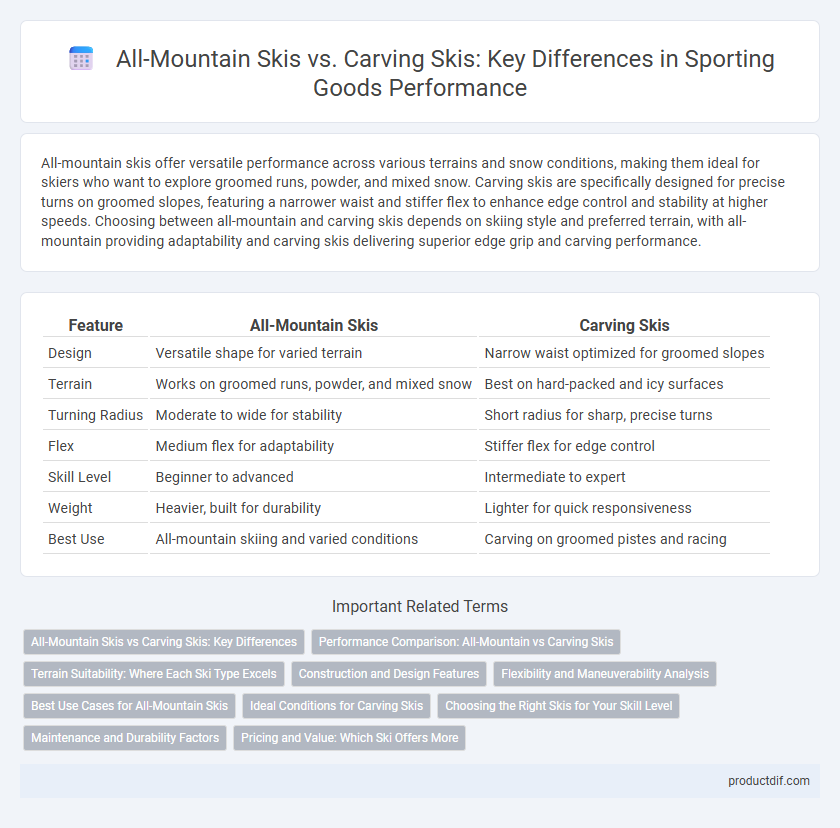All-mountain skis offer versatile performance across various terrains and snow conditions, making them ideal for skiers who want to explore groomed runs, powder, and mixed snow. Carving skis are specifically designed for precise turns on groomed slopes, featuring a narrower waist and stiffer flex to enhance edge control and stability at higher speeds. Choosing between all-mountain and carving skis depends on skiing style and preferred terrain, with all-mountain providing adaptability and carving skis delivering superior edge grip and carving performance.
Table of Comparison
| Feature | All-Mountain Skis | Carving Skis |
|---|---|---|
| Design | Versatile shape for varied terrain | Narrow waist optimized for groomed slopes |
| Terrain | Works on groomed runs, powder, and mixed snow | Best on hard-packed and icy surfaces |
| Turning Radius | Moderate to wide for stability | Short radius for sharp, precise turns |
| Flex | Medium flex for adaptability | Stiffer flex for edge control |
| Skill Level | Beginner to advanced | Intermediate to expert |
| Weight | Heavier, built for durability | Lighter for quick responsiveness |
| Best Use | All-mountain skiing and varied conditions | Carving on groomed pistes and racing |
All-Mountain Skis vs Carving Skis: Key Differences
All-mountain skis provide versatility for varied terrains and snow conditions, featuring a wider waist width (typically 85-100mm) for stability in powder and groomed runs, while carving skis have a narrower waist (usually 65-75mm) designed specifically for crisp, precise turns on hard-packed snow. The rocker-camber-rocker profile of all-mountain skis enhances adaptability and float, contrasting with the aggressive camber profile of carving skis that maximizes edge grip and responsiveness on groomed slopes. Skiers prioritize all-mountain skis for multi-condition performance, whereas carving skis excel in creating clean, carved arcs on well-maintained trails.
Performance Comparison: All-Mountain vs Carving Skis
All-mountain skis offer versatile performance across varied terrain and snow conditions, providing stability and control for both groomed runs and off-piste adventures. Carving skis are designed for precision and speed on groomed slopes, featuring a narrow waist and a pronounced sidecut to execute sharp, clean turns with minimal effort. While all-mountain skis prioritize adaptability, carving skis excel in responsiveness and edge grip, making them ideal for aggressive, high-speed carving on hard-packed snow.
Terrain Suitability: Where Each Ski Type Excels
All-mountain skis excel in versatility across varied terrains, performing well on groomed runs, powder, and light off-piste conditions, making them ideal for skiers seeking adaptability. Carving skis specialize in precision and control on groomed slopes, featuring a narrower waist and tighter sidecut for efficient edge-to-edge turns and optimal grip on hard-packed snow. Choosing between all-mountain and carving skis depends on terrain preferences, with all-mountain skis suited for mixed environments and carving skis best for groomed piste performance.
Construction and Design Features
All-mountain skis feature a versatile construction with moderate width and rocker-camber-rocker profiles, enabling adaptability across varied terrain and snow conditions. Carving skis have a narrower waist and a pronounced sidecut radius, combined with stiffer materials and camber underfoot for precise edge control on groomed slopes. The design differences emphasize all-mountain skis' multi-surface capability versus carving skis' superior grip and responsiveness on hardpack.
Flexibility and Maneuverability Analysis
All-mountain skis offer enhanced flexibility with a softer flex pattern, allowing for smoother turns and adaptability across varied terrains, whereas carving skis feature stiffer flex for precise edge control on groomed slopes. The increased maneuverability of all-mountain skis supports quick responsiveness in mixed snow conditions, while carving skis prioritize stability and sharp turning radius for high-speed carving. Skiers seeking versatility benefit from the forgiving flex and agile handling of all-mountain models, contrasted with the targeted control and power transmission inherent in carving skis.
Best Use Cases for All-Mountain Skis
All-mountain skis excel in versatility, making them ideal for skiers who navigate varied terrain including groomed trails, powder, and occasional off-piste conditions. Their design balances stability and maneuverability, providing reliable performance in diverse snow conditions and gradients. This adaptability makes all-mountain skis the preferred choice for intermediate to advanced skiers seeking one pair for all types of runs.
Ideal Conditions for Carving Skis
Carving skis excel on hard-packed groomed slopes where precise edge control and high-speed turns are essential. Their narrow waist and stiff construction optimize performance for icy conditions and firm snow, delivering superior grip and stability. These skis perform best on groomed trails, enabling skiers to maintain clean arcs and dynamic carving techniques.
Choosing the Right Skis for Your Skill Level
All-mountain skis offer versatility for intermediate to advanced skiers by handling various snow conditions and terrain, making them ideal for those progressing in skill. Carving skis are designed for advanced skiers focusing on groomed slopes, providing precise turns and stability at higher speeds. Selecting skis that match your skill level ensures better control, safety, and overall skiing performance.
Maintenance and Durability Factors
All-mountain skis generally require more frequent edge tuning and base repairs due to their use in varied terrain, which impacts their long-term durability. Carving skis, designed primarily for groomed runs, tend to maintain edge sharpness longer but can suffer damage if used aggressively off-piste. Proper waxing and regular inspection of both types significantly enhance their lifespan and performance on the slopes.
Pricing and Value: Which Ski Offers More
All-mountain skis generally provide greater value for a broader range of conditions, balancing price with versatility as they accommodate various terrains and snow types. Carving skis tend to come at a higher price point due to their specialized construction, optimized for precision on groomed runs, but may lack the adaptability of all-mountain options. For skiers seeking cost-effectiveness and flexibility, all-mountain skis deliver more overall value, whereas carving skis cater to those prioritizing performance and technique on specific slopes.
All-Mountain Skis vs Carving Skis Infographic

 productdif.com
productdif.com